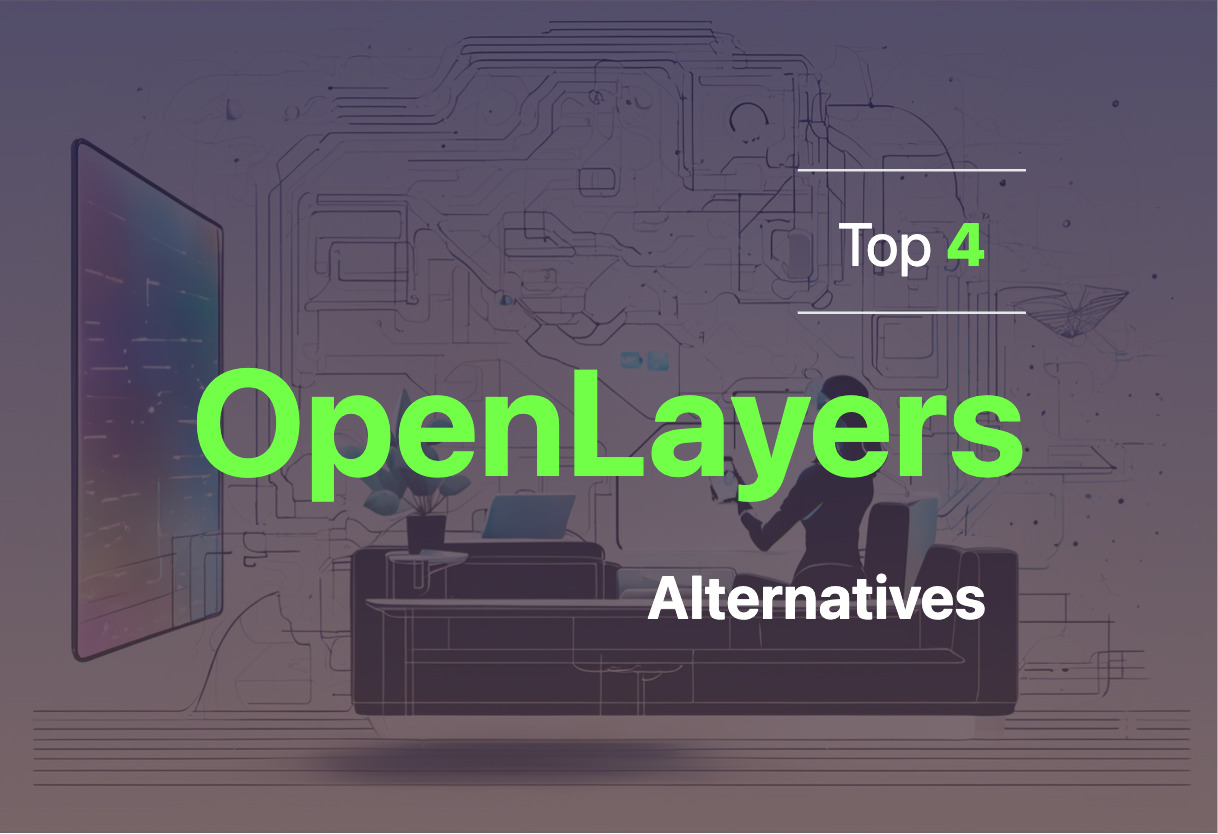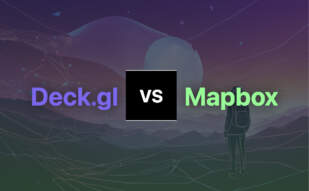OpenLayers is a top player in map applications, focusing on web-based solutions that support various data formats like geo-referenced images and vector tiles. Its robust API simplifies map application setups and handles complex requirements with ease. The company showcased its prowess in the 2019 Finland road analytics and provides detailed guidance on Github for developers to quickly integrate OpenLayers into their projects.

To explore options beyond OpenLayers, consider Deck.gl, Mapbox, Cesium, and D3.js in your tech arsenal for diverse mapping and data visualization needs.
Deck.gl
An esteemed player in the field of large-scale data visualization, Deck.gl transforms the way you comprehend and manipulate vast swaths of data. Designed with the power of WebGL2 and a laser focus on performance, this highly customizable tool is a prime example of tech’s global impact and its integral role in showcasing digital diversity.
Deck.gl Top Features
- Highly Efficient: Specially crafted for tackling large-scale data, Deck.gl simplifies what could be a tedious process.
- Layered Framework: Data, in the form of JSON, serves as the foundation for creating visual layers inclusive of icons, polygons, and text.
- Diverse Views: Offers map, first-person, and orthographic views to achieve a comprehensive understanding of the data.
- Interactive Events: Elevating user interaction with features like picking, highlighting, filtering is a breeze with Deck.gl.
- Cartographic Projections: Makes integrating with major basemap providers a smooth process.
- Customization: With flexible APIs, extendable core classes, and a rich offering of usage modes ranging from Script Tag to React and Python.
| Learning Tools | Third Party Integration |
|---|---|
| API docs, demos, interactive playgrounds (Codepen, Observable), Medium blog, Slack workspace | deckgl-typings, mapdeck, vega-deck.gl, earthengine-layers, deck.gl-native, deck.gl-raster |
Deck.gl Limitations
- Requires a steep learning curve for those new to working with JSON and large-scale data.
- High customization can feel overwhelming to some users.
- No built-in support for traditional databases.
Deck.gl Pricing
Deck.gl is a proud part of the open source community, operating under the OpenJS Foundation – another testament to tech unity and inclusivity. Hence, it’s absolutely free for use.
Deck.gl Use Cases
Use case 1: Data Analysts and Scientists
Deck.gl can be a powerful tool for professionals in data science and analytics. The global impact of such data insights drives cross-cultural decision-making.
Use case 2: Developers
Developers leveraging WebGL for creating immersive interfaces find Deack.gl’s versatility a game changer.
Use case 3: Researchers
Researchers needing to process and visualize large amounts of data can utilize Deck.gl for comprehensive and understandable representations.
Mapbox
An outstanding leader in the realm of web graphics, Mapbox is a potent location data platform. It was carved from the ingenuity of web developers with a vision to create dynamic maps in web browsers using vector tiles and 3D rendering technologies. Mapbox extends a robust suite of services including routing, navigation, delivery matrixing, and many more, effectively powering maps and location services in apps.
Top Features of Mapbox
- Enterprise-grade location, traffic, and movement data.
- Impressive APIs for Maps, Search, Navigation, Vision, and Accounts services.
- Fluid support for web, mobile, automotive, and gaming applications.
- Reliable map data updates through mobile sensors, driver feedback, cameras with computer vision, and aerial imagery.
- Powerful 3D rendering technology with the ability to draw maps using geospatial data from vector tiles.
| Mapbox GL | An exceptional tool that makes use of vector tiles and style instructions from a style document to create visually stunning maps. |
| Boundaries, Traffic, and Movement | These are premium data products that elevate the capabilities of Mapbox. |
| Developer Resources | Mapbox empowers developers with extensive documentation including guides, tutorials, glossary entries, and troubleshooting resources. |
Mapbox Limitations
- Free tier services are mostly designed for development phases, making high-frequency use in production applications potentially costly.
- Reliant on a complex array of sources for map data updates that could impact consistency.
Mapbox Pricing
Mapbox embodies affordability with its detailed pricing model tailored for developers. Free tier services are available for typical usage during the development phase. Metered services are used for production applications with active users. In 2019, its pricing was revised to include increased free tier access for almost every product, along with publicly disclosed prices for all services. The pricing model is designed to reduce friction for builders and offers volume discounts triggered by increased usage. There are no commercial restrictions, and individual API pricing is adopted for specific usage cases.
Mapbox Use Cases
Web and Mobile Development
Mapbox boosts web and mobile applications with its dynamic map rendering capabilities, making it highly relevant to developers in these domains.
Automotive Sector
The automotive industry can leverage Mapbox’s adept speed and precision in capturing traffic and movement data.
Gaming Applications
With its 3D rendering technology, Mapbox serves as an innovative tool for gaming applications, bringing to life accurate and vivid environment designs.
Cesium
Cesium is an advanced, versatile platform for Augmented Reality (AR) solutions, offering tools for both personal and commercial uses. This platform operates under Apache License Version 2.0, encouraging a universal undertaking of technological innovation.
Top Cesium Features
- Scalability: With plans that cater to a range of needs, Cesium provides a scalable solution for AR development.
- Unlimited Apps: There are no restrictions on the number of apps and end users, fostering digital expansion and exploration.
- Diverse License Usage: Its licensing framework covers a comprehensive range of operations, including reproduction, distribution, and performance.
| Feature | Description |
|---|---|
| Apache License | Grants a perpetual, worldwide, non-exclusive, no-charge, royalty-free, irrevocable license. |
| Third-Party Patents | Includes pending patents and confirmed patents contributing to innovation and advancement. |
| Contributor Acknowledgement | Recognizes all contributors, emphasizing the collaborative spirit of the tech universe. |
Cesium Limitations
- Paid Account Requirement: Annual gross revenues or raised funds in excess of $50K necessitate a paid account.
- Commercial and Government Licensing: Both government and commercial project developments require a paid license.
Cesium Pricing
With a pricing spectrum from free to custom, Cesium caters to varying needs. The Community package is free for non-commercial use, while solutions for faster commercial services start with the Commercial package at $149/month. The Premium package at $499/month provides higher streaming and storage capabilities. The Custom plan offers a scalable solution with a price upon inquiry.
Cesium Use Cases
Use Case 1: Personal Endeavor
Cesium’s Community plan, which is free, provides an avenue for personal projects and non-commercial development. This fosters exploration and learning in a cost-effective way.
Use Case 2: Government Project
For government projects, Cesium’s commercial license provides an expedient platform for the delivery of advanced AR solutions.
Use Case 3: Funded Educational Research
For funded educational research, Cesium’s commercial license ensures the fluid development and execution of complex AR projects.
D3.js
Stepping beyond the boundaries of traditional charting tools, D3.js, a JavaScript library is known for its potent ability to generate dynamic, interactive data visualizations directly within web browsers. Grounded on SVG, HTML5, CSS standards, D3.js is a successor of Protovis framework, engineered to provide a expressive framework and focus on improved performance.
D3.js Top Features
- Operates on low-level approach, leveraging web standards for dynamic, data-driven graphics authoring.
- Comes with pre-defined functions for elements selection, SVG creation, styles application, transitions, dynamic effects, and tooltips.
- Enables data-binding for bespoke visualization through direct binding of large datasets to SVG objects.
- Supports a wide range of data formats including JSON, CSV, and geoJSON.
- Offers fine control over transitions, to smoothly interpolate values for attributes and styles over time.
| Dynamic SVG Graphics Generation | Charts and diagrams created according to provided data, enabling unique text and graphic results. |
| .enter() Function | Enables efficient binding of datasets to a document, promoting a rich, interactive visual experience. |
D3.js Limitations
- Doesn’t operate as a standard charting library, lacking the concept of “charts”.
- May be an overkill for private dashboards or one-off analyses, as it aims at catering to full-scale media organizations.
- Requires user skill for composing individual primitives to visualize data, due to its flexibility and lack of an overarching “chart” abstraction.
D3.js Pricing
Signifying the true spirit of digital democratization, D3.js is a free, open-source library accessible to all.
D3.js Use Cases
Use case 1 – Dynamic Content Generation
With its focus on dynamic, interactive visualizations, D3.js is a potent tool for media organizations seeking to elevate their digital content experience.
Use case 2 – Data-Driven Visual Storytelling
Academics and researchers can leverage D3.js utility to narrate compelling, data-driven stories, making comprehensive analyses engaging and understandable.
Use case 3 – Data Visualization Projects
Data visualization practitioners can use D3.js for hatching intricate, expressive presentations of large datasets in their projects.
Tiffany Brise
Content writer @ Aircada, patiently awaiting a consumer AR headset that doesn’t suck.





